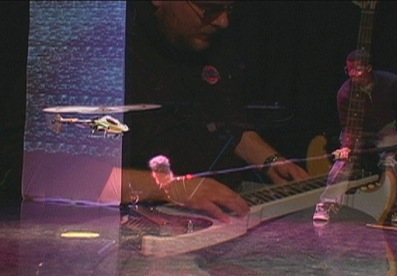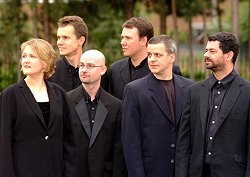The world has always been violent, hence the classical desire to restrain the beast within. But is this kind of art enough when the world seems to spin out of control more and more each day, with headlines soaked in blood, and anger and distrust every way you turn? Should art address disjunction/disconnection, or should it act like Bocaccio, who entertained his guests with stories while the plague raged outside his door?
These are essential questions, and The San Francisco Ballet’s four- work Program 5, which I caught Saturday evening 15 March at the Opera House, seemed whether consciously or not, to be asking them. And all the music here was either modern or contemporary.
Brit choreographer Christopher Wheeldon’s Pas de Deux from After the Rain (2005), uses Arvo Part’s 1978 violin/ piano duo “Spiegel im Spiegel “, as its score, which was played here live by Roy Malan, and Bruce McGraw. Composed just after Part parted company with serialism, it’s not as interesting or as fresh as some of his 80’s and 90’s work which can be quite striking, and sometimes very affecting too. Sure, you can read it as meditative, or “spiritual”, but music that’s performed in the theatre had better have some dramatic juice, and Part’s piece didn’t. And Wheeldon’s dance for the alienated/struggling couple – Sarah Van Patten and Pierre-Francois Villanoba – made it sound like a kind of decorous décor. But the dancers brought lots of nuance to their parts which often depended on very slow lifts.
Wheeldon’s Carousel (A Dance), which was first performed in Richard Rodgers’ centennial year–2002–at Lincoln Center, was an hommage to this wonderful composer. And while the choreographer studiously avoided using anything that smacked of Broadway, what he came up with was obvious – having the dancers move in a circle like a slowly gyrating carousel, or letting them become carousel horses with poles attached to an non-existent top – and trite. Recent revivals of Rodgers’ 1945 musical have apparently stayed closer to the dark tone of Ferenc Molnar’s play Lilom, which Hammerstein based his book on. But Wheeldon’s dance wasn’t the least bit dark, though Mark Stanley’s expert lighting was. The choreographer’s use of vernacular movement made it look contemporary, but in his heart of hearts he seems to be a let’s be a polite at all times classicist. Still, the 24 strong corps, who’d performed it six hours before, and soloists Dores Andre and Joan Boada, made it look almost effortless.
A similar lack of connection to the musical material at hand undermined Helgi Tomasson’s 2008 dance – this was its premiere – to Rachmaninov’s 1934 Rhapsody on a Theme of Paganini. Why any choreographer would deliberately ignore this score’s variation structure is anybody’s guess, but this one defiantly did. Either the music inspires, or it doesn’t, and if it doesn’t what’s the point? Tomasson’s setting was so blandly unimaginative – ditto Martin Pakledinaz’s scenic and costume design – that I kept wishing I could see the orchestra, but my friend and I were parked on the ground floor. Music director Martin West and his band gave a serviceable and streamlined modern take on the score, with no string portamenti to give it extra expressivity. But piano soloist Roy Bogas, whose teacher Rosina Lhevinne exemplified the Russian romantic style, used rubato at several points to give it rhythmic variety, just as Rachmaninov did when he played this piece.
Neither rhythmic variety nor textural subtlety figured in either music or dance in Wayne McGregor’s Eden/Eden, which the Stuttgart Ballet premiered in that city last year, and I think its point of origin says a lot about the final product. The Germans. after all, have never been big on giving their audiences unalloyed pleasure, but beating them up with “important “ messages, and this piece certainly tried to be important.
Charles Balfour’s lighting made everything look deadly earnest, and McGregor’s choreography for nine, emphasized angularity, and a kind of physical dysfunction which had to be meaningful. Steve Reich’s aggressively monochromatic score sounded like the snare drum tattoos in Bolero on auto pilot. But what does one expect from a composer – what’s happened to this once vital artist? — who sits down with his wife and collaborator on this piece, vid artist Beryl Korot, to choose the most significant technological events of the 20th century, form THREE TALES (2002), of which this, Dolly, is the last? Dolly is of course the sheep cloned in 1997, and Reich and Korot’s talking heads, from MIT and Oxford – mercifully absent here – go on and on about this issue. The composer even dragged out a quote from Genesis – “ And G-d placed him in the garden of Eden, to keep it and to serve it, “ to give it mythical stature, and McGregor seemed to buy it.
A white tree of the knowledge of good and evil descended from the flies, and some of the dancers came and went via a lift in the stage. McGregor and his game dancers produced some striking and even nightmarish images. But a piece that starts in the head, and stays there, can’t be anything but dead on arrival. Guest conductor Gary Sheldon and his musicians produced harsh, overly amplified, and badly mixed sounds, which assaulted the ear. Eden/Eden failed to say anything fresh, and will, I think, date quickly “like yesterday’s mashed potaotoes” in Dorothy Fields and Jerome Kern’s song “ A Fine Romance.“ When you’re on you’re on, and when you’re not, you’re not.


 (OK, OK I know, the puns don’t come any worse than that…) No F.Z. music, but rather a reminder that The excellent U.K. ensemble Psappha (with help from Lancaster University and the BBC Singers) is in the middle of a
(OK, OK I know, the puns don’t come any worse than that…) No F.Z. music, but rather a reminder that The excellent U.K. ensemble Psappha (with help from Lancaster University and the BBC Singers) is in the middle of a